THE WAY I HEAR, Fuchu 2012-2013 / Fuchu Art Museum Open Studio Program 57
OPEN STUDIO@@@@@Listening@@@@@Research@@@@@Performance@@@@@Leaflet
2013.02.16
performer / m: mamoru, H:Kohei Hashimoto (audio operation), O: Ai Onoda, A:Akie Mitsukado
m:Thank you all for coming out today. My name is mamoru. Have you gone to the exhibition upstairs? I am showing several works from my getude for everyday lifehseries, which I have been working for the last 5 years or so. But todayc
THE WAY I HEAR, Fuchu 2012- <writing on the Whiteboard(=WB)>
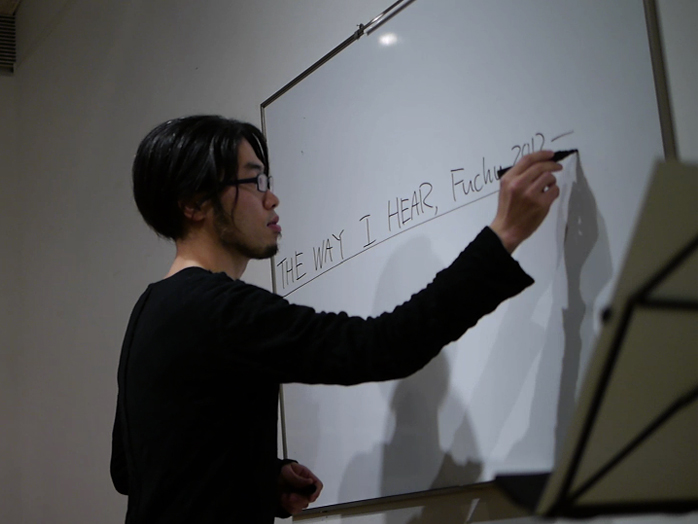
excerpt from video: Lee Basford
mFTHE WAY I HEAR. It is about the way of listening. For example, the works in the exhibition deals with a kind of intense listening to listen to the subtle sound. During the OPEN STUDIO period, 3-4 month, I have thought about different types of sound, and listening. I would like to introduce some of them today.
You might be wondering what I am talking about, so letfs hear some examplesc
<A:Run the water from the water tap in the studio. First turn the tap fully, and then close to the half.>
m: I am sure you hear this sound. You are listening to this sound through your ears, and how do you name this sound?
audienceFSound of water?
mFSound of water.@<write it on the WB, upper left>
mFCan you phrase it in other way?
audience: Water tap?
mFWater tap.@ <write it on the WB, upper left>
Any other?
audience:shuuuuu jyabujyabujyabuc
m:Oh, ok. Onomatopoeias. Any other way?
Maybe you can just say the stream of water, or simply water.@ <write them on the WB, upper left>
<AFturn the tap off>
mFThe sound that you hear at the exhibition, and this sound from the water tap<pointing out the location in the studio> are the same type of sound, and alsoc
<m: walking around the studio, making sound of footsteps with the boots>
This is, off course, footsteps <write on the WB, leftside>, and it is also a same type of sound. One more examplec
<O: open the slide door, heavy glass, and then close it>
Yes, this is also a same kind.
<A: turn on the electric kettle when hearing the footsteps>
Can you hear it? <gesture of listening/putting a hand on a ear> Can you?
audience: boiling sound?
mFThe other day, the person didnft recognize the sound source and said radio sound. Yes, it is boiling sound. She just boiled the water from the water tap.<write gboiling waterhon the WB> This is also in the same category of sound, and I would just call it simply as thegraw sound.h<write on the WB, down left> The sound that are generated in time, and in this space.
Then, this would be a different kind of soundc
<H: play the 4ch-surround recording of Ookunitama shrine>
Do you hear this? <pointing out gfootstepshon the WB>
What else can you hear?<listening gesture>
audience: some airily noise.
mFOh! Thatfs a very difficult one to notice. Some kind of sound from the vent hole or something. Ventilation<write it on the WB, left> This is very interesting.
<a child is crying outside the studio>
By the way, that child is not a performer. That is just happening. Well, what else can you hear?
<recording: clapping sound>
What is this?
<recording: clapping sound>
audience: clapping<write it on the WB, upper left>
mFYes, it is clapping sound. So, can you guess where we are?
audience: Oh! Shrine!
mFI guess most of Japanese people can guess that. (people clap their hands twice when making their wish/prayer.) I have recorded this sound at the Ookunitama shrine near Fuchu station.
This kind of sound can be called as grecorded soundh<write it down, down center)
We are not in the temple, so it is different context, but if I write it down, then they both are hand clap. The same can be said as the footsteps. We heard it live and through the recordings.
Let me clarify what we have heard so far.
If you record the graw soundhwith microphone and other equipments, it makes the grecorded soundh, and you can play it back via equipments as well.<write on the WB>
When the action/phenomenon such as walking,boiling water, explosion takes place, it makes the graw soundh. <write a chart on the WB>
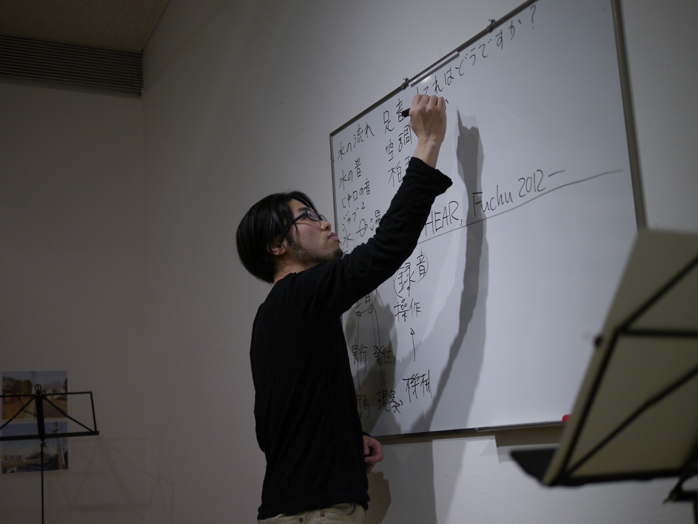
photo: Lee Basford
Then, <The following sentences until noted are written on the WB without speaking of a word only with gestures.>
WB: How about this?<looking towards the audience
Canft you hear something?<look towards the audience, listening gesture>
When you read this sentence gCanft you hear something?h<point out the previous sentence that has written a moment ago, then look towards the audience>
In your mind. Canft you hear something? ?h<point out the previous sentence that has written>
WB: OK. Can you say gAhhhhhhhhhhhhh<look towards the audience>
audience: gAhhhhch<outloud>
WBFNo, no. Just in your mind.
audience: laughter
<m: gesturing with hands to hold the sound in the audience mind, and close hands to end the sound as the conductor would do to the orchestra>
WB: Low Ahhhhhhhhh <conductor gesture>
WB: High Ahhhhhhhhh <conductor gesture>
WB: Much Higher Ahhhhhhh <conductor gesture to raise the pitch of the sound>
<m: By the gesture, separate the audience in half, assign left half with gLow Ahhhhhhand the other half gHigh Ahhhhhh, then conductor gesture to make, hold, and end the sound. This is the end of WB writing plus gesturing>
m: Did you all hear it clear?
This maybe little different from what you experience, but cc
<m: point out the sentence on WB gstream of waterhand circle it with a red marker, listening gesture>
m: How is it? Can you now hear it?
I am not sure how I can call this kind of gsoundh<write it on the WB> However, THE WAY I HEAR is to call these as sound.
Let me clarify as we did to two other types of sound, raw and recorded sound.
So, we did something, so that the gwordshmade the sound in our mind.
audience: Imaging?
m: Yes. But to image, wec
audience: read
m: Yes, thatfs it. We greadhthe gwordshand heard the sound.<write down on the WB>
I want you to look out this handout that I prepared. <A+O: pass the handouts to the audience>
2011.10/06 15F19-27
Cafe KINH DO near the church
I hearc
Egirls chatting in the cafe behind me
EFrench tourists chatting in the cafe next to me
EStudents calling each other on the street
Emen making jokes, laughing in front of me
Ea cafe worker pulls the plastic chairs
Ebig refrigerator of the shop (continuous)
Egirls eating the sun flower seeds breaking
Ehorns of the motorbike and cars
EI move my chair a little bit
Enew customer making their order and greeting their friends who were already there
Esome students (elementarily school?) running around
Esomeone put his engine of the bike on
Ea cafe worker starts to clean some coffee cups in the backv
m: It would only take you for a minuet or so to glistenhto it.
Does it start resonating your ears? Whatfs your impression?
It says Cafe already on the paper, so it is in a cafe, but what elsec
audeicen: I mean I can hear it but I can also see the image.
m: Yes. I guess that is very natural reaction. What kind of place do you think it is?
audience: I see it as a cozy place that look like very sunny but not really.
m: I see. Cozy place.
audience: I was imaging if I am with anyone or by myself or c
m: It is actually interesting to locate yourself as a person taking this memo or someone else in the place or as a person who is reading the sentences.

photo: Lee Basford
m: Well, I wrote this in a Cafe that I often went in Hanoi where I stayed over a month in 2011. So, you just read my memo of my 7-8 min listening memo. Someone thought it is in France since there is a word like gchurchh.
m: This can be the example of <pointing out the greading words makes soundhon the WB>.
In Fuchu City, I have visited a lot of places, as you see them on the wall <pointing out the printout images on the wall>. I took the similar listening memo in those places, sometime more like mapping out. I simply listened to the sound and did not confirm the situation with my sight as much as I could. If I heard 2 person passing by, I just wrote down something likeg2 person passing byhwithout looking at them if they were really 2. I have done this listening research with students from Musashino Arts University, and we exchanged each otherfs memo to imagine the location of others. As we did that several times, we made up a game of imaging the soundscape just with the photo image. <put the photo of the street of Shinmachi on the WB>
m: There is nothing special about the photo or the location. But, can you imagine the sound?
audience: I heaer a motorcycle or bicycle passing by.
m: Yes, I can imagine it here or maybe over there.
audience: Someone talking?
m: Talking.
m: Birds.
m: Yes, birds. So you can hear it from the picture.
What we are doing to the photo is c
audience: seeing?
m: Yes. We gseehthe gphoto/picturehand heard the sound. <write it on the WB>
And did you realize that we have been practicing another way of ghearinghsound since the beginning of the performance?
m:What did you say a little while ago? <pointing the audience>
audience: Birds?
m: Yes. You said gbirdsh. OK How about you?
audience: Motorcycly or bycycly passing byc
m: Did you heard it? I guess partly because we have been looking at the picture, but I am sure when he said the word gbirdsh, we heard it. The same goes to the Motorcycle and bicycle. We heard when we heard the words been said.
We glistenh to the gverbal descriptionhand heard the sound. <write it on the WB>
Listening is the trigger of the realization of sound. <pointing out the sentences on the WB> I have extended the definition of listening into the ways I have introduced to you so far. And this is how I perform it.
<putting the music stand, the lights off, only the spot on the performer>
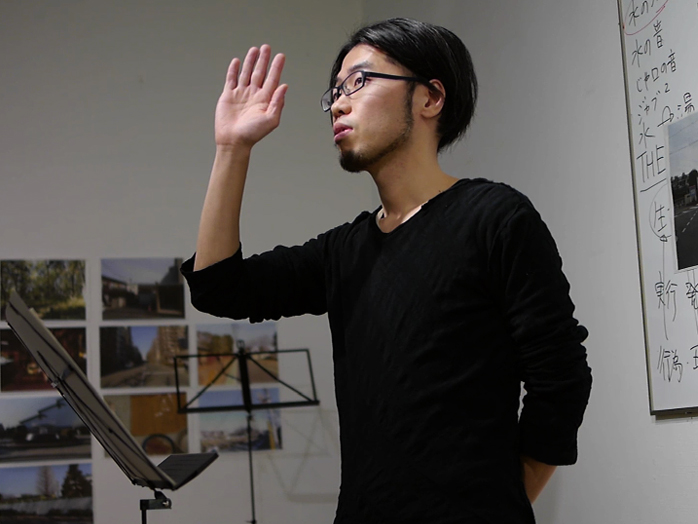
excerpt from video: Lee Basford
mF
2012.11.7 Wed. sunny, light wind, calm day of an autumn
12:36 start listening
something falls down from the tree right behind me
from the bush in front of me, the insects start to buzz
all around me, birds are calling
nearby, a bird chirps louder than the others
a small fly acrossing in front of me
in the distance, cars coming and going
just behind me, someone passes by
a little distance away, a bird rustling on the ground
down the hill, a mechanical announcement saying "the track is moving backc"
over the sky, an aircraft slowly passing by
a little distance away, children playing around
down the hill, horns of the car
an airplane flying low, gradually flying away
a little distance away, children laughing
somewhere over the sky, a helicopter is coming closer
something falls down from the tree right behind me
in the bush in front of me, the insects stop buzzing
somewhere in the woods, a bulbul chirps
the trees swaying in the breeze
12:47 finish listening
m: If you go little towards that way from this place, there is gMt. Sengenh<write it on the WB>
It is the highest peak in the Fuchu City. However, you imagine just by hearing gthe highesth, it only is about 80m from sea level.
Isnft it small as the highest? Anyway, the Mt.Sengen is not just the highest, but the data shows that it has been there for very long. Long long time ago, when this entire area of Musashino field was formed, there was the ancient Riv.Tama. You can find the layer that contains the remain of this river all around the Fuchu area; however, from the Mt.Sengen, there are traces of ancient Riv.Sgami, which is several hundreds thousand years older than ancient Riv.Tama. So, in short, I can say that the Mt.Sengen has been there for a very lond time.
I know a lot about it, donft I? as a person who misread the Chinese character of the mountain in the first place.
Well, I have spent a lot of time listening <pointing out the sentence gwords-read-make soundhon the WB> those books that you see in the show case <pointing towards the glass furniture in the corner of the studio>. When I was going through many documents <gesturing flipping pages of book>, I listened to the sound in there.<listening gesture>
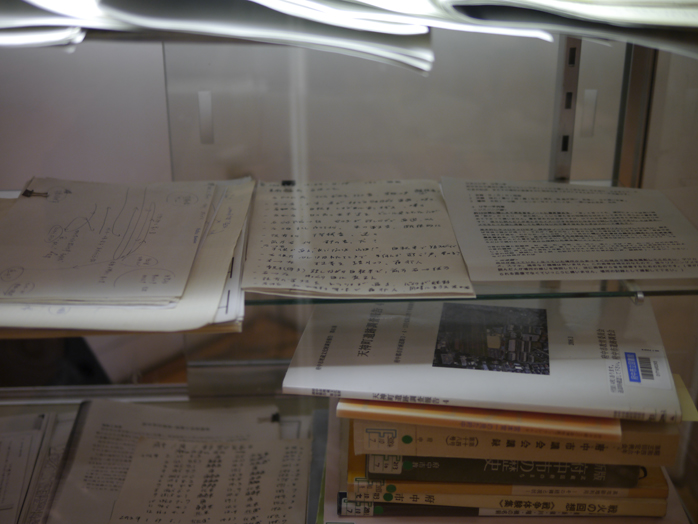 photo: Lee Basford
photo: Lee Basford
Also, I found out the word gMusashinoh<write it on the WB> kept appearing in many of the documents describing the characteristics of the Fuchu area.
I think those people who can imagine what it is like just by seeing the words are probably local to this area. However, I grew up in the west side of Japan, and just by hearing the word gMusashinoh, there is no chance for me to imagine the scenery or what so ever. So, I googled the word, try to find out the literature related to it, and then found this. I want you to gread/listenhto thisc
<A+O: pass the handout 02 experts ofgMusashinohby Doppo Kunikida>
gMusashinohby Doppo Kunikida, 1898
On my journal of the October 26th, I have written that I went deep into the woods, sat down, looked around, started listening intensely, squinted, and meditated. (an ommision) How it is suitable to listen to the sound in Musashino around the end of Autumn or into early winter. There you would hear the sound from inside the woods in fall, and some sound echoing far in the woods in winter.
The birds are flying and singing. The wind is breezing, ringing, boasting, or shouting. Behind the bushes, the insects sing together in chorus. The push carts are running all around the woods; going down the hill, passing through the pathes around. The sound of hoofs on the fallen leaves. This can be a calvalryman practicing or maybe a couple of foreigner having a lond ride on their horses. I can hear some villagers husky voice, talking something out loud. It fades away. A woman walking alone, fast, lonely. In the distance, the gunfire echoing. Suddenly, there are gunshots in the neighboring woods.
Once before, I heard something fallen down deep in the woods. It was when I visited the woods near by my place with my dog in the woods and started reading a book on a stump. My dog looked into the direction where the sound came from. It only sounded once. It is probably a chestnut since there are many chesnuts tree all around Musashino.h
m: Can you go through the text?
The text is a part of an essay called gMusashinoh, which was written by Doppo Kunikida in 1898. Some of you may have heard his name or read the text before? It is not just the title that attracted me, but the fact that he had done such a similar practice of listening! I mean He was ahead of me, off course, so that makes I had been doing the similar thing as he did!
Off course, there must have been many, who listened to the sound around them and wrote down. However, it is actually very rare to encounter such a clear description of the soundscape of location that you are interested in. The only thing is we actually canft tell where his gMusashinohexactly is. Since, in his time, Musashino meant most of the Kanot area which includes Tokyo, even Shibuya and so on. He used to live near Shibuya, so some researcher believes it is around there, or some studies show it is near Koganei, which is close from here. I thought it could be here in the same sense, then.
I kept on glisteningh. <gesturing page flipping>
Then, I met Tsuneichi Miyamoto. I said gI meth, meaning that I found the pictures he took <put up a photo of Mt.Sengen on the WB>, his sentences about Fuchu, and listened to the sound from them.
Tsuneichi Miyamoto, who was a folklore researcher, wrotegMy Map of Japanhwhile he traveled around Japan, took tons of photos of peoplefs daily lives. He had lived in the north end of Fuchu City from 1961 for 20 years until his death. Although, he was teaching at the Musashino Art University, he was constantly traveling around and was absent from home.
There is a passage I would like to read from thegMy Map of Japanh.
gI got off at Kokubunji station, and to the south exit.
Then go towards south for a while, and turn left,
There you see the a small alley with Japanese zelkova.
Huge zelkova, its long branches full of leaves.
On the both side of the path, I saw some new houses, but several thatched houses.
I really felt that I had come far into the countryside.
Turning right from there, and walk a little, there were barley fields.
I heard a skylark singing.
Behind one of the field, there were a few houses, and one of them was on sale."
m: He bought the house, and since then, lived for 20 years until 1981, and walked around here some often.
I can show you the route that I had just introduced to you.<pointing out the map on the wall>. This is a map of Fuchu City. Some of you may know, but I will explain its basic location. The southend of Fuchu goes along the Riv.Tama, and on its north end, there is Kokubunji City, and east side is Koganei. Here is the Kokubunji stationc<pointing the station on the map>
<H: play 4ch-surround recordning of gKokubunji satation, after mamoru mentioning the word gKokubunji stationh>
<O: walk on to the stage, prepare own music stand>
m: From the station, as it says in the Tsuneichifs sentence, you go towards south, turn left. Maybe the zelkova trees were around here. The area that used to be those barley fields now is the residential area. There is Shinmaci, where Tsuneichi used to live. It is the intersection of 3 citiescc
O: <start reading the following description overlapping mamorufs comment>
gThere were lots of people around Kokubunji station since it was a holiday of the year end.
Next to the entrance of the station, there was a bender selling new year greeting cards.
We came out of the station, and started walking towards south.
Going down a steep road, cross a small river, and turned left on the third block. Suddenly, the noise of the streets disappeared.
After walking through the residencial area for about 10 min or so, there we found some Japanese zelkova that looked like ones Tsuneichi Miyamoto wrote about.
Then, there was a small street with several shops, and the three-forked road that was on the old photograph appeared.
We tried to look for Tsuneichifs house location, however we werenft able to find it, and took a rest near by.h
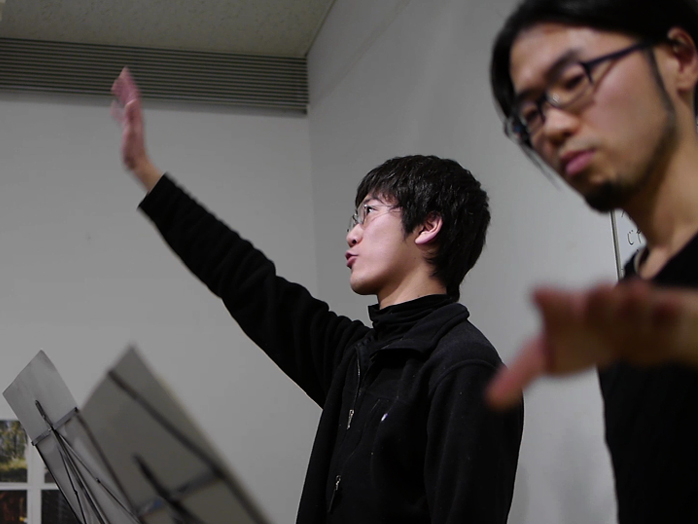
excerpt from video: Lee Basford
m+O:
m: 2012.12.23. Sunday, Cloudy, breezing, cold day
11:07 start listening
m: on the next street, a car passing by
m: near by, a bird chirps
m: a little distance away, a men saying ggood morningh, gexcuse meh
m: 11:10
a little distance away, engine of the car started
O: nearby, the signal sound of the car moving backward
m{O: in front of us, a car passing by
m: the car stopps, door opens and closes
O: over the sky, birds singing some often
m: 11:11
m;just behind me, sound of the vacium cleaner, a window opens and the sound gets louder
{O: from a little far, suddenly, sound of the vacuum
O: nearby, birds calling
m: in a little distance, someone knocking on a door, sayinggMrs.---h
O: over there, a car slowly passing
m: 11:13
m: the vacuum clearner stops, somebody is organizing some stuff in the room
m+O: just over there, sliding door of the car opens, and shuts
m: the car moves backward
m: far away, a crow chirps
O: on the next street, a man running down
m: over the street, a man saying ggood morningh, gI am from the YAMATO transportationch, gToday, itfsc.h
{O: a little distance away, a man and woman talking
m: on the next street, two ladies walking down, talking out loud
O: I realized that the sound of vacuum cleaner was not there anymore.
m: a distance away, a man saying ggood morninghagain
m: 11:15
m+O: the vacuum cleaning starts again
m: from the room, middle aged couple talking
O: the next street, a man running down
m: nearby, a car engine sounding
O: a little away, vacuum cleaner, a voice of a woman
O: over the sky, a crow chirps
m: from the bush in front of me, a bird singing
O: nearby, a bird singing
m: a little bird flies away
m: 11:17 finish listening
mF
gAfter I got settled in Fuchu, I decided to walk around the area whenever I had the time. There were rows of zelkova trees everywhere, and most of the oldest ones were over 200 years old. One day, as I was walking along one of those roads, a slightly elevated hill appeared before my eyes. (abridged) Later, when I looked at my map, I realized that it was Mount Asama.h (My Map of Japan, Musashino/Ome)
Tsuneichi Miyamoto apparently made repeated trips to Mount Asama. I decided to train my ears and glistenh to the photos that he took<<putting a photo on the WB>>, as well as various maps from his time<gesture of listening>, in order to revisit Mount Asama. But this is Mount Asama as it was in 1968. <writing 1968 on the WB>
mF
Cloudy, giving way to clear weather, with a light wind, a warm day
Birds singing nearby
A little distance away, the sound of footsteps and the clatter of farming tools
All around me, occasionally, barley fields and trees swaying in the wind
Far away, the sound of a car driving over a gravel road
In the distance, children playing
The sound of a helicopter drawing closer
The helicopter passes overhead with a piercing roar
a skylark chirping nearby and flying away
The sound of spring water right in front of me
Just next to me, some insects start to buzz
Far in the distance, the sound of trumpets and wind instruments playing the American national anthem
The wind instruments die down
Nearby, more insect sounds
I canft hear the sounds of those children playing anymore
All around me, insects buzzing
Far in the distance, a train passes
Nearby, a cuckoo calls
And I carry on listeningc
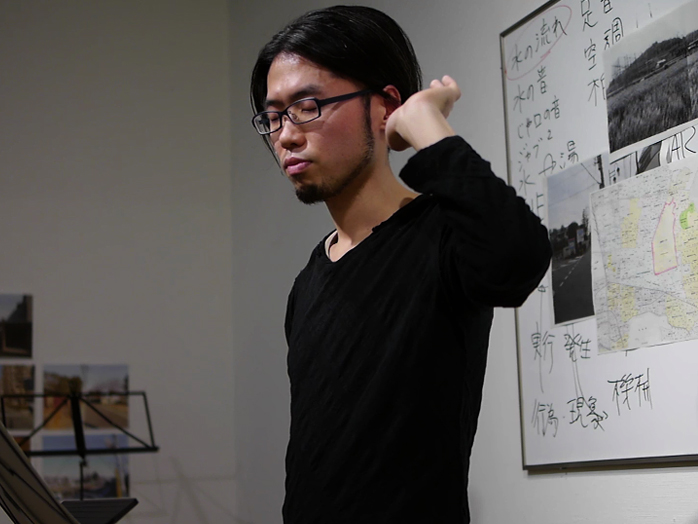
excerpt from video: Lee Basford
m:
The official record of the Fuchu City Council. The third assembly of 1971.
The 14th suggestion from the member of the council; about making the official request on the helicopter noise deriving from US Air base.
m/chairman: Mr.Junichi Yabe, I would like you to give your explanation regarding the 14th suggestion.
m/Mr.Yabe: The suggestion has already been discussed in the special committee of environment pollution. We concluded that the suggestion should be made. The residents around the air base are constantly annoyed with the high frequency noises, which occurs in the morning and night when the helicopters take off. Also, they fly around the elementary school nearby, so that the pupils cannot concentrate on studying sometimes. We are intending only to suggest that they can change the location of the heliport in the base, not insisting to stop flying the helicopters.
gAgree!hsomeone shouts
m/chairman: Mr.Ryosaku Yoshida.
m/Mr.Yoshida: The helicopters take off and land more than ten times a day when it happens the most. They fly from several directions, even after midnight. The other day, there were so many of them when the gNixon Shockh happned. Therefore, the residents around the base are interrupted their sleep and they are very much mentally damaged. Sometimes, they also cause explosive wind and it turns some of the wooden doors. We are hearing that an old woman was injured for that. It also wiped some laundries away. In short, there are many concerns regarding the current situation. We, as the city representatives, are wishing to solve the matter for the residents. Therefore the suggestion should be made.
m/chairman: I would like to leave the matter to me.
gNo objectionhsomeone shouts.
m/chairman: Since there is no objection to my proposition, the suggestion is approved.
m: I kept listening to the sound in Fuchu <pointing the images on the wall>, kept reading the documents <gesturing page flipping>, looking at the maps <putting a photo of the US air base taken in 1048 from above the sky>, and eventually came back to this place, right here but of 1941.<write g1941hon the WB>
mF
1941.10.23 Thursday clear, warm day of an autumn
10:30 start listening
birds singing in the surroundings
nearby, continuous low sound from the boiler, occasionally short puffs of steam
some distance away, all kinds of industrial sound, hitting and lathing metal
just over there, a truck passes by on the street
the sound of construction from a distant place
right in front of me, two young men passing by, talking,
"we have to push the octane rating much higherc"
"I hear that tons of coal is arrivingc"
far away, oil drums hit each other
10:35, a little distance away, a steam whistle
nearby, a truck driving over pebble road
10:38, a whistle again, and the steam locomotive is getting closer
the steam locomotive passing with its brake screaming
10:39, the steam locomotive making stop
little away, a man makes a command, "Now, Unload it!"
a big noise resounding all over the place
nearby, a truck driving back over pebble road
from a distant place, a man orders, "Start the fire drillc"
the insects start buzzing around me
m: I carry on listening.
m: gAround that time, among the fuel laboratory of Japanese Imperial Army was so liberated that you might not even think it belongs to the army. Young researchers often discussed feverishly.
However, as the war situation turns bad on the Japanese side, we dug a lot of shelters all around the laboratory. The ones that were only for a person were called eoctopus potteryf. I remember that we also went to Mt.Sengen to make large shelters. It was extremely hot summer.
Hiding in the shelter became the daily routine. In my eoctopus potteryf, there was a flog. It somehow made me relaxed. I said to my guest that wefd be getting along in there.h
mF
2012.12.24 cloudy, chilly outside
18:50 start listening
music of Thelonious Monk playing solo piano from the loud speaker nearby
around the ceiling, noise of the air conditioner
the door opens up, someone enters the cafe
the record turns to the next song
18:51, a lady talks to the owner, "I would like to buy some coffee c"
the owner replies,"well, I have some mocha c"
the conversation goes on
water hitting the sink, sound of dish washing, and the water is boiling
footsteps crossing in front of me
the ice cubes touching the glass
at the table next to me, a young man and a woman talking
a spoon touching the ceramic dish
some coffee beans sliding into the grinder
18:58, from the table next to me, taking off the plastic package
the record turns to the next song
a woman says, "it fits!", "Wow, I'm so glad c" continue
a machine grinding coffee beans for a little while
19:00 finish listening
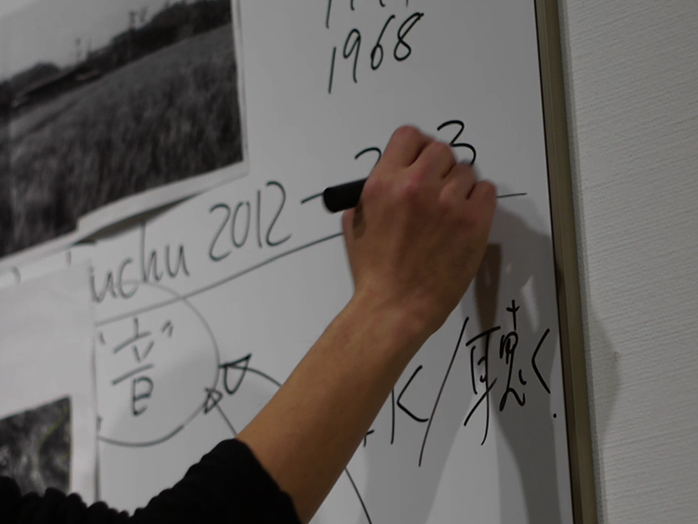
excerpt from video: Lee Basford
m: <write g2013hon the WB> The new year began. I went to the Mt.Sengen again. <walk around the studio>
m+O+A:
m: 2013.1.13. Sunday, Sunny, breezing, warm day of the winter
13:19 start listening
A: far away, a bird is calling
A: in a little distance, a car passes by with loud noise
m: in the distance, a bulbul chirps with high voice
O: over my head, birds calling each other
A: just near by my side, someone drawing a circle with a pen
m: over the hill, men shouting gHey!h, gCome on!h, a metal bat hitting a baseball
{O: down the hill, people playing baseball, calling each other out loud, hitting balls
A: in a little distance, someonefs clothe making a subtle noise
A: just by my side, someone writing with a pen, clothe making some noise
A: a little far away, footsteps on the fallen leaves
O: down the hill, motorcyclefs engine roars
A: from distance, motorcyclefs engine roars
m: 13:20
in front of me, a person passing by, running
{A: very near, a person running
m: far away, a bird makes a call
A: in the distance, childrenfs voice echoing
O: in a little distance, noise,gGiiiiiiiih
A: just near by, someone breathing
m: near by, birds are singing
A: very near, footsteps, slow
A: in a little distance, a bird chirps
m: 13:22
m{A: in a little distance, a child loudly sayinggMom, Mom, I canft seeh
{O: near by, , a child loudly saying gMom, I canft seeh
A: far away, people playing baseball
m: in the disntance, cars and motorcycles passing by, sometimes a big truck passes making low sound
{A: far away, sometimes big cars passing by
O: in front of me, someone writing with a pen
A: near my hands, a paper flips
m: in front of me, someone writing with a pen
A: near by my side, clothe making noise
m: 13:25
{A: over the sky, an airplane passing by
{O: over the sky, a helicopter or an airplane passing by
{m: over the sky, a small airplane, slowly passing
m: 13:26
the sound fading out into sky
A: in the distance, people chatting
O: I hear some noise as I scratch my noses
m: in front of me, someone writing with a pen
A: far away, motorcycle makes a loud sound
m: clothe making noise
A: in the distance, something makes sound
O: in front of me, someone touches its head
A: far away, cars passing by
{mFnear by, a bird chirps
A: over the sky, a crow chirps
m: in the distance, a crow chirps
O: in a little distance, footsteps on the fallen leaves approaching
m: in front of me, sound of little bells, footsteps, passing by, going away
{A: near by, footsteps
O: down the hill, a car makes a loud brake
A: far away, a car stops with a loud brake
O: down the hill, a large motorbike stops
A: near by, a man coughes, a woman talking
{m: far away, a crow chirps
O: over my head, birds are calling each other
m: 13:29 finish listening
A:
g'What is that?' We were chatting, pointing out strange hut, went on the zigzag path, going down the hill. I see some acorns scattered around on the fallen leaves.
After crossing the busy street and then going straight in the residential area, we saw the woods.
After walking a little while, turning right, there is this metallic fence all around the woods, refusing people to reach the ruins in it. The sign says 'KEEP OUT'
The Fuchu Museum is just in front of it."
m:
The woods around the area are called gsuspended zone.h
On Nov.8th, 1974, the American national flag was put down <gesture>, and the next year, in 1975 vast land which was used as the American base was returned to Japanese.
After years of negotiation between the nation and the state/city, the land eventually was split in 3; One for the Japanese Selfe Defence Air Force as the national territory <pointing the map on the wall>, another 1/3 to be made into the public part run by the state, and the rest as thegreservationhsurrounded with metal fence, and with U.S.A.fs communication facilities/radar installation left on it.
1988, driven out of a national strategy, the Japanese government made a plan for the reservation.
Big trucks coming in and going out, bringing all sorts of construction materials; such as reinforced steel, concrete, and so on.
The National Institute of Health.
The apartments for the researchers and other workers of the institution.
All the other facilities that belongs to them.
The sound of peoplefs everyday life.
<pose>
c would have been there.
The local residents fought against the plan, and nothing has built on the reservation until today.
The time has just gone by. Now, the reservation has turned back into the original condition; thegMusashinoh <pointing out the word on WB>, the woods.
I listened to the sound. <listening gesture>
m:
2013.1.24.
I was visiting a library in the Ookunitama shrine to interview some people there.
footsteps, going up the stairs, greetings
I sat down. A lot of documents were brought onto my table. I went through and listened to its sound.
gDo you have any question?h
I took out my memo. There was an underline on a word greservationh, not to forget asking about it.
He took out a map<put the map of Fuchu City on the WB>, and started talking about very interesting fact about the area.
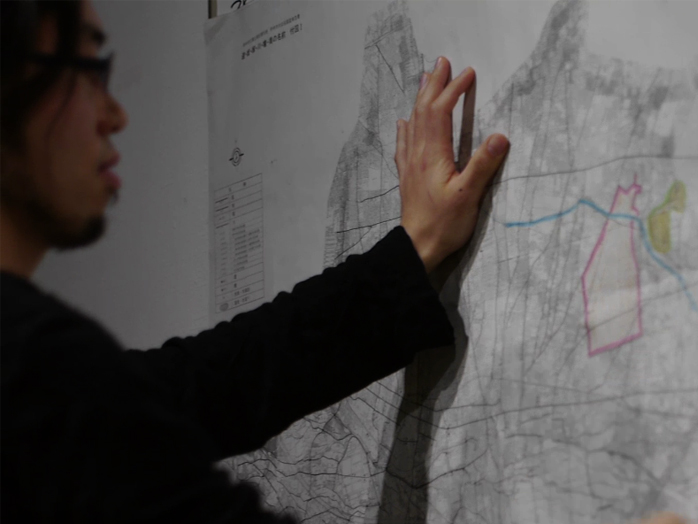
excerpt from video: Lee Basford
gWell, there are a lot of archeological sites in the city, you know. Since 1975, the city has investigated most of them, and we have found important artifacts and architectural remains from them. But, you know, this area had belonged to Japanese army then G.H.Q./U.S.A., so it hasnft been dug.h
<H: play the recording of the interview of Mr. Nakayama>
recordning: gOur investigation was making progress, and several remains of the Old Stone Age were found, and one of them were named Tenjincho remain. It shows that there had been a river there. This is the trace of the river here on the map. I mean this river was going through the reservation area, therefore we had assumed that some more remains could be found if we could dig in the reservation. I actually had an opportunity to go inside of the area once. It was for the preparation of building the national laboratory.
(m and the recording goes at the same time)
m: In shortc
r: When we researched on sight, it showed the strong possibility of some archeological remains
m: He saidc
r: Around the Tama station as well
m: In the reservationc
r: we would find something there for sure.
m: we would find something there for sure.
m:
Long long time ago, there was the ancient Tama river running in the area. The bottom of the river shaped the land, and made the pit.
Even after years, the pit sometime got filled and a temporary stream of water appeared. Gathering the spring water around, and additional heavy rain could be the causes sometimes.
The stream could have started from here around the prison, and passes the Tenjincho area,
I kind of remember the person who grew up in Tenjincho had mentioned about it in his interviewc
<H: playing the recordings of the interview of Mr. Kouda>
gThere were lots of trees around here. I also remember that we had spring water, and there was a stream of water, very thin one that you wouldnft call it as a river. Yes, there was this water. However, the land was kind of shaped like a valley, so when there was a typhoon, it did become like a small river.h
The stream went through the reservation, and passed the south side of Mt.Sengen.
The sound she heard might have been related to that?
<H: playing the interview of Mrs. Miki>
gDo you about the spring water around here? I remember this small river. There used to be this stream around that spring.h
m: I opened the sliding door of the studio, walked towards the entrance, and went out from the museum,
Then I turned right, crossed the street, and climbed over the metal fnece.
Going deep into the bushes, looking some ruins of the US Base on my right, I walk further on the worn out concrete road into the woods. I look around, and listend to the sound.
mF
2013.2.16.
16:05 start listening
in the distance, a car passing
just behind me, something falls down from the tree
a dog barks, from somewhere
over the sky, an airplane crosses
trees and branches swaying in a wind,
rain drops start to fall down on the trees and the fallen leaves on the ground
all around, birds calling
in front of me, a stream of water
16:15 finish listening
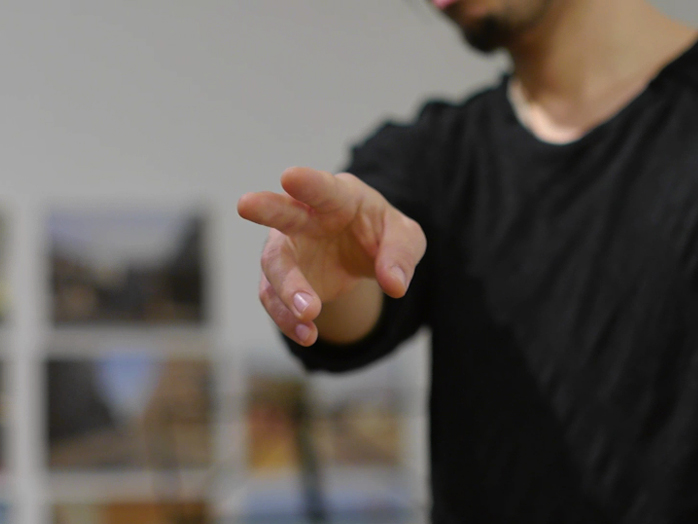
excerpt from video: Lee Basford
Thank you very much for your listening.
I will introduce my performers. From your right, Ai Onoda, Akie Mitsukado, Kohei Hashimoto on audio recordings.
What you have heard now is based on my personal listening. As I mentioned in the beginning, THE WAY I HEAR does not necessary aims the accuracy by confirming with sights or other means and senses, but rather to perceive the world primally through listening